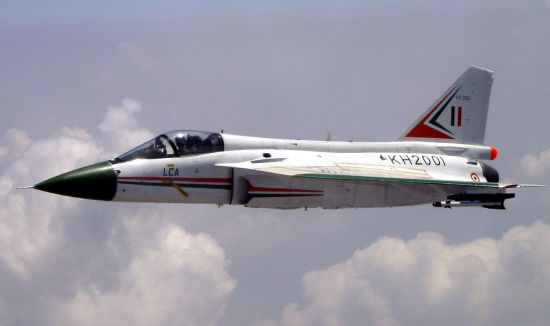 LCA is an advanced technology, single seat, single engine, supersonic, light-weight, all-weather, multi-role, air superiority fighter designed for air-to-air, air-to-ground and air-to-sea combat roles. LCA is the world's smallest, light weight, multi-role supersonic combat aircraft. It has been designed to meet the requirements of Indian Air Force as its frontline multi-mission single-seat tactical aircraft.The LCA design has been configured to match the demands of modern combat scenario such as speed, acceleration, maneuverability and agility. Short takeoff and landing, excellent flight performance, safety, reliability and maintainability, are salient features of LCA design. The LCA integrates modern design concepts like static instability, digital fly-by-wire flight control system, integrated avionics, glass cockpit, primary composite structure, multi-mode radar, microprocessor based utility and brake management systems.
LCA is an advanced technology, single seat, single engine, supersonic, light-weight, all-weather, multi-role, air superiority fighter designed for air-to-air, air-to-ground and air-to-sea combat roles. LCA is the world's smallest, light weight, multi-role supersonic combat aircraft. It has been designed to meet the requirements of Indian Air Force as its frontline multi-mission single-seat tactical aircraft.The LCA design has been configured to match the demands of modern combat scenario such as speed, acceleration, maneuverability and agility. Short takeoff and landing, excellent flight performance, safety, reliability and maintainability, are salient features of LCA design. The LCA integrates modern design concepts like static instability, digital fly-by-wire flight control system, integrated avionics, glass cockpit, primary composite structure, multi-mode radar, microprocessor based utility and brake management systems.
 The LCA programme was conceived in 1983. The project definition phase was completed in 1989 and the full scale engineering development (FSED) phase-I was sanctioned in 1993. The development effort for LCA is spearheaded by the Aeronautical Development Agency (ADA), an autonomous society under the Department of Defence Research & Development. ADA is responsible for project design, project monitoring and promoting the development of advanced technologies of relevance to the LCA. The principal partner of LCA is Hindustan Aeronautics Limited (HAL) and its divisions located in Bangalore, Hyderabad, Lucknow, Nasik, and Korwa.
The LCA programme was conceived in 1983. The project definition phase was completed in 1989 and the full scale engineering development (FSED) phase-I was sanctioned in 1993. The development effort for LCA is spearheaded by the Aeronautical Development Agency (ADA), an autonomous society under the Department of Defence Research & Development. ADA is responsible for project design, project monitoring and promoting the development of advanced technologies of relevance to the LCA. The principal partner of LCA is Hindustan Aeronautics Limited (HAL) and its divisions located in Bangalore, Hyderabad, Lucknow, Nasik, and Korwa.
It is India's second indeginous fighter, the first one being the 1960's HF-24(Hindustan Fighter) 'Marut'. 129 Marut fighters were manufactured. Marut had limited supersonic capability (It could go supersonic in dives). The LCA will be the first supersonic combat aircraft to be built and flown in India itself. Interestingly, the requirements of both LCA and HF-24 and very similar. India had previously attempted to build a supersonic fighter : the HF-73, a development of the Marut. HF-73 was to use engines with more power. The project was cancelled after a crash.
Seven weapon stations provided on LCA offer flexibility in the choice of weapons LCA can carry in various mission roles. Provision of drop tanks and inflight refueling probe ensure extended range and flight endurance of demanding missions. Provisions for the growth of hardware and software in the avionics and flight control system, available in LCA, ensure to maintain its effectiveness and advantages as a frontline fighter throughout its service life. For maintenance the aircraft has more than five hundred Line Replaceable Units (LRSs), each tested for performance and capability to meet the severe operational conditions to be encountered.The avionics system enhances the role of Light Combat Aircraft as an effective weapon platform. The glass cockpit and hands on throttle and stick (HOTAS) controls reduce pilot workload. Accurate navigation and weapon aiming information on the head up display helps the pilot achieve his mission effectively. The multifunction displays provide information on engine, hydraulics, electrical, flight control and environmental control system on a need-to-know basis along with basic flight and tactical information.
On 04 January 2001, India's Light Combat Aircraft LCA flew for the first time. The LCA completed its first batch of tests in 12 flights instead of 15 - ahead of schedule - on June 2, 2001.There has been some delay in Light Combat Aircraft (LCA) Project which is mainly due to lack of development experience, non-availability of ready infrastructure, foreign exchange crunch of 1992, sanctions imposed by USA in 1998 and technological complexities. The first technology demonstrator has flown on January 04, 2001 and successfully demonstrated to international experts during Aero India 2001. Further development is in progress for its timely induction in Indian Air Force.
A video taken at the first flight of the LCA.
The maiden flight of the Light Combat Aircraft (LCA) Technology Demonstrator II was carried out at 1147 hrs in Bangalore June 6, 2002. The flight was successful and met all test parameters set for the flight. The flight lasted 28 minutes and was a significant landmark in the LCA project and marks its entry into the Flight Test Programme. The purpose of flight test program is to validate a number of advanced technologies incorporated in the LCA. These include unstable configuration, Quadruplex fly-by-wire Digital Flight Control System, Integrated Avionics with glass cockpit, advanced composite materials for primary structure and a novel Utility Systems Mangement System.
'Full-scale' induction of the LCA into the IAF won't happen anytime before 2010. Further delays are expected. Most critics put the date of induction between 2012 and 2015, if it is inducted at all. Apart from the MiG-21, LCA will also replace MiG-23 and MiG-27, also in service with the IAF.
